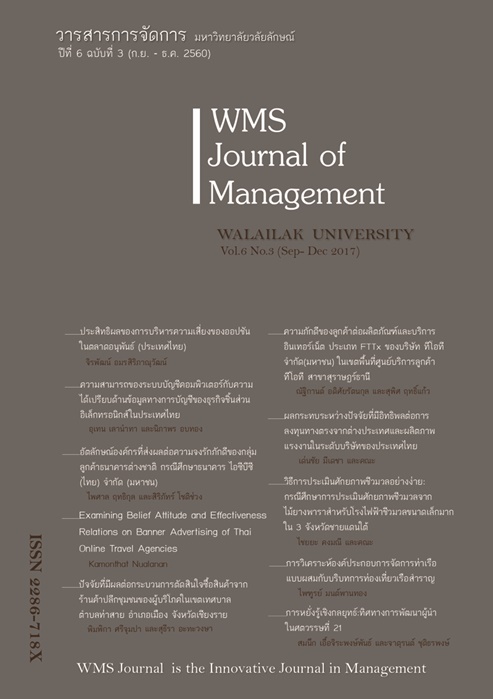Corporate Identity that Affect Customer Loyalty to A Foreign Bank Case Studies, Bank of China (Thailand) CO.,LTD.(Thailand)
Main Article Content
Abstract
Article Details
References
จินดาลักษณ์ เกียรติเจริญ. (2555). ภาพลักษณ์ธนาคารกสิกรไทย จำกัด (มหาชน) สาขาปิ่นเกล้า ที่ส่งผลต่อความจงรักภักดีของลูกค้า. ปริญญาบริหารธุรกิจมหาบัณฑิต, สาขาวิชาการประกอบการ, มหาวิทยาลัยศิลปกร.
ฐิติมน มิ่งทัสน์. (2549). ภาพลักษณ์ของธนาคารออมสินหลังปรับเปลี่ยนอัตลักษณ์ขององค์กรตามความคิดเห็นของประชาชนในเขตสมุทรปราการ. สาขาการบริหารทั่วไป, คณะรัฐประศานศาสตร์มหาวิทยาลัยบูรพา.
ไทยรัฐออนไลน์. (2558). จีนแซงสหรัฐฯขึ้นแท่นเศรษฐกิจใหญ่ที่สุดในโลก. ค้นเมื่อวันที่ 20 กรกฎาคมพ.ศ. 2558, http://www.thairath.co.thธนาคารแห่งประเทศไทย. (2558). สถิติธนาคารพาณิชย์ . ค้นเมื่อ 15 ตุลาคม 2558, สืบค้นจาก https://www.bot.or.th
ธนาคารไอซีบีซี (ไทย). (2557). ประวัติความเป็นมาธนาคารไอซีบีซี (ไทย ) จำกัด (มหาชน ). ค้นเมื่อ 4 มกราคม 2558, สืบค้นจาก http://www.icbcthai.com
ธานินทร์ ศิลป์จารุ. (2552). การวิจัยและวิเคราะห์ข้อมูลทางสถิติด้วย SPSS. พิมพ์ครั้งที่ 10 กรุงเทพฯ: สานักพิมพ์บิสซิเนสอาร์แอนดี.
เนตรชนก พึ่งเกษม. (2545). การสื่อสารแบบผสมผสานกับการสร้างอัตลักษณ์และภาพลักษณ์ธนาคารพาณิชย์.ปริญญานิเทศศาสตร์มหาบัณฑิต, สาขาวิชาโฆษณา คณะนิเทศศาสตร์, จุฬาลงกรณ์มหาวิทยาลัย.
ปิยพงศ์ พู่วณิชย์ และ วิโรจน์ เจษฎาลักษณ์. (2558). อิทธิพลของการกากับดูแลกิจการที่ดีและการรับรู้คุณภาพการบริการของลูกค้าที่มีผลต่อความไว้วางใจและความจงรักภักดีของลูกค้าธนาคารออมสิน. ปริญญาบริหารธุรกิจ, สาขาวิชาการประกอบการ คณะวิทยาการจัดการ, มหาวิทยาลัยศิลปกร.
พันธนันท์ เหล่าเขตวิทย์. (2554). การตลาดบริการของธนาคารพาณิชย์ในเขตกรุงเทพมหานครที่มีผลต่อความจงรักภักดีของลูกค้า. ปริญญาบริหารธุรกิจมหาบัณฑิต, มหาวิทยาลัยอิสเทิร์นเอเชีย.
พนม วิกัยรุ่งโรจน์. (2551). การวิเคราะห์สีอัตลักษณ์ และผลต่อภาพลักษณ์องค์กร. ปริญญาวิทยาศาสตร์มหาบัณฑิต, สาขาวิชาเทคโนโลยีทางภาพ, คณะวิทยาศาสตร์ จุฬาลงกรณ์มหาวิทยาลัย.
วิระพงศ์ จันทร์สนาม. (2551). ผลกระทบของการบริหารลูกค้าสัมพันธ์ต่อความจงรักภักดีของลูกค้าของธุรกิจพาณิชย์อิเล็กทรอนิกส์ในประเทศไทย. ปริญญาบริหารธุรกิจมหาบัณฑิต, สาขาวิชาการจัดการเทคโนโลยีและพาณิชย์อิเล็กทรอนิกส์, มหาวิทยาลัยมหาสารคาม. กองบรรณาธิการวารสารการเงินการธนาคาร, 2558 ( 396), 171-173 .
สยามสปอร์ต ซินดิเคท จำกัด (มหาชน) (2559).7อันดับยูนิฟอร์มสาวแบงค์ที่มีความเก๋มั่นใจไม่มีนับเงินผิด. ค้นเมื่อวันที่ 1 พฤษภาคม 2559,http://www. girldaily.com/fashion/fashion-talks/1003708.
ศุภวัตร มะเส็ง. ผู้ช่วยผู้อำนวยการฝ่ายบริหารภาพลักษณ์ และการสื่อสารองค์กร ธนาคารไอซีบีซี (ไทย) จำกัด. (25 พฤศจิกายน 2558). สัมภาษณ์.
Ailawadi, K.L., & Keller, K.L. (2004). Understanding retail branding: conceptual insights and research priorities. Journal of Retailing, 80, 331-342.
Balmer, J.M.T. (2001). Corporrate identity,corporate branding and corporate marketing:Seeing through the fog . European Journal of marketing, 35, 250.
Brand Finance. (2015). Global 500 2015
http://brandfinance.com (สืบค้นเมื่อวันที่ 9 ตุลาคม 2558).
Bloemer, J., & Odekerken, S.G. (2002). Store satisfaction and store loyalty explained bycustomer-and store-relatedfactors.Journal of Consumer Satisfaction, 15, 68-80.
Bidin, R., Muhaimi, A., & Bolong, J. (2014).Strategising Corporate Identity for the Perception ofCorporate Image in the Selected Government-linked Companies (GLCs) in Malaysia. Procedia-Social and Behavioral Sciences, 155, 326-330.
De Reuver, M., Nikou, S., & Bouwman, H. (2015). The interplay of costs, trust and loyalty in a service industry in transition: The moderating effect of smartphone adoption. Telematics and Informatics, 32(4), 694-700.
Drennan, J., Bianchi, C., Proud, B., Cacho-Elizondo, S., Correia Loureiro, S., & Guibert, N. (2015). Examining the role of wine brand on brand loyalty: A multi-country comparison . International Journal of Hospitality Management, 49(1), 47-55.
Grinffin, J. (1995). Customer Loyalty:How to Earn it, How to Keep it. San Francisco : Jossey Bass Publishers.
Gray, E.R., & Balmer,J.M.T. (1998). Managing corporate image and corporate reputation. Long RangePlanning, 34(5), 696.
Hosseini, R. S., & Zainal, A. (2016). The Effects of Indirect Experience of Hotel Customers on Brand Association and Loyalty in Iran. In Proceedings of the 1st AAGBS International Conference on Business Management 2014 (AiCoBM 2014) (pp. 417-426). Springer Singapore.
Hosseini, R. S., Zainal, A., & Sumarjan, N. (2015). The Effects of Service Performance of Hotel Customers on Quality of Experience and Brand Loyalty in Iran. Procedia-Social and Behavioral Sciences, 201, 156-164.
Isabel, B., Sara, C., & Eva, M. (2015). brqARTICLEThe importance of corporate brand identity in businessmanagement: An application to the UK banking sector. Business ResearchQuarterly, 1-10.
Jefkins, F. (1982). Introduction to Marketing,Advertising and Public Relations. London:Macmillan.
Keller, K. L. (1993). “Conceptualizing Measuring, & Managing Customer-based Brand Equity,” Journal of Marketing. (57), 1-22.
Kotler, P. (2007). Marketing Management (11th ed). New Jersey : Prentice-Hall Inc.
Melewar, T. C. & Jenkins, E. (2002). Defining the corporate identity constructs. Corporate Reputation Review, 5(1), 76-90.
Melewar, T. C. & Karaosmanoglu, E. (2006).Seven dimensions of corporate identity: A categorization from the practitioners perspectives. European Journal of Marketing, 40(7/8), 846-869.
Maurya, U. K., Mishra, P., Anand, S., & Kumar, N. (2015). Corporate identity, customer orientation and performance of SMEs: Exploring the linkages. IIMB
Nguyen, N. (2006). The collective impact of service workers and servicescape on the corporate image information. International Journal ofHospitality Management, 25( 2), 227– 244.
Nguyen, N., Leclerc, A. & Leblanc, G. (2013). The Mediating Role of Customer Trust on Customer Loyalty. Journal of Service Science and Management, 6(1), 96-109.
Qiu, H., Ye, B. H., Bai, B., & Wang, W. H. (2015). Do the roles of switching barriers on customer loyalty vary for different types of hotels?. International Journal of Hospitality Management, 46, 89-98.
Tu, Y. T., Liu, C., & Chang. (2014). Y. Customer Commitment as a Mediating Variable between Corporate Brand Image and Customer Loyalty. Journal of Education and Vocational Research, 5, 17-27.
Van Riel, C.B.M. (1995). Principle of corporate communication. Boston, UK: Prentice-Hall.
Westcott Alessandri, S. (2001). Modeling corporate identity: a concept explication and theoretical explanation. Corporate Communications: An International Journal, 6(4), 173-182.
Yusof, J. M., Manan, H. A., Karim, N. A., & Kassim, N. A. M. (2015). Customer's Loyalty effects of CSR Initiatives. Procedia-Social and Behavioral Sciences, 170, 109-119.
Yoo, M., & Bai, B. (2013). Customer loyalty marketing research: A comparative approach between hospitality and business journals. International Journal of Hospitality Management, 33, 166-177.


